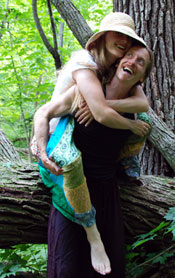Taste Test: Evergreen Teas
There are a lot of plants out in the wildlands and back yards that make for great teas. In the interest of culinary curiosity, today we thought we’d have a showdown between the Red and White Pines, with a Norway Spruce thrown in for variety. We collected the needles, attempting to gather a similar amount for each cup, and poured boiling water over the top. They steeped for ten minutes each. Here are the results:
Color
We had assumed we’d see a golden color, but instead the teas were shades of pink. The White and Red pine teas brought up an interesting conjecture. Could the names of these trees be due in part to the colors of their teas? The White was almost colorless, while the Red was surprisingly pink.
Aroma
White Pine
Rebecca: Earthy aroma with a hint of Christmas tree
Kenton: Lighter scent, slight lemon aroma
Red Pine
Rebecca: Initial scent of red pine bark or sap, followed by pungency
Kenton: Strong and a bit harsh
Norway Spruce
Rebecca: Very subtle aroma, like green tea
Kenton: Depth of scent, slight earthiness
Taste
White Pine
Rebecca: Very light on the tongue and filled with soft full flavor. An initial very subdued Christmas tree flavor ending with an almost nutty taste.
Kenton: Very subtle, easy to drink. Pleasant all around.
Red Pine
Rebecca: Tastes strongly of the smell of a warm red pine forest in the middle of summer. Strong earthiness with an acidic finish of tannins.
Kenton: Earthy, robust, and full. Distinct pine taste.
Norway Spruce
Rebecca: Tastes like the smell of freshly cut grass mixed with green tea. Finishes with a very subtle pine-y flavor. Light and pleasing to the palate.
Kenton: Delicious. Smooth, round, with pleasant resin overtones. Slight bite in back of throat after swallowing.
The winner:
Kenton: Spruce. It has enough punch to keep your cup interesting, but isn’t as harsh as the Red. The White was definitely my second favorite - it was pleasant, but I felt myself hoping for a little more character.
Rebecca: I’m going to say that white pine is my favorite, although the spruce is a close second and I would probably alternate between the two depending on what type of mood I was in. The red pine I found to be a bit overwhelming to my taste buds, although that could simply be in comparison to the other types. The funny thing is that I thought I would dislike all the evergreen teas because I think of them as so strong. I was delighted to discover that I actually enjoy their flavor. I recommend brewing a few different varieties and trying them for yourself - then let us know which one is your favorite and why!
Posted on March 13th, 2009 by Kenton and Rebecca
Filed under: Plants | 11 Comments »


